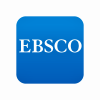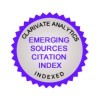Research Article
Aim & Scope
Ankara Review of European Studies (ARES) is a leading refereed
journal in its field, aimed at publishing original, high quality
articles on the European Integration. Since 2001, the Review has
been striving to accumulate and disseminate knowledge in the field of
European Studies focusing inter alia on legal, economic,
political and historical aspects of the integration process, both from
theoretical and empirical perspectives. ARES aims to achieve a
disciplinary balance between law, political science, economics and
international relations. The editors are also open to submissions based
in other social science disciplines. As well as full academic articles,
book reviews and case studies/reviews/comments are also published in the
Review. The Review is published bi-annually in June and December and in
Turkish and English languages.
Ankara Review of European Studies (ARES) is a leading refereed
journal in its field, aimed at publishing original, high quality
articles on the European Integration. Since 2001, the Review has
been striving to accumulate and disseminate knowledge in the field of
European Studies focusing inter alia on legal, economic,
political and historical aspects of the integration process, both from
theoretical and empirical perspectives. ARES aims to achieve a
disciplinary balance between law, political science, economics and
international relations. The editors are also open to submissions based
in other social science disciplines. As well as full academic articles,
book reviews and case studies/reviews/comments are also published in the
Review. The Review is published bi-annually in June and December and in
Turkish and English languages.
Author Guidelines
Footnote Writing Principles
The footnotes in the works that are submitted to be published in Ankara Review of European Studies should be in line with Chicago style (Notes and Bibliography).
Notes and Bibliography: Sample Citations
The following examples illustrate citations using the notes and bibliography system. Examples of notes are followed by shortened versions of citations to the same source. For more details and many more examples, see chapter 14 of The Chicago Manual of Style.
Book
One author
- Michael Pollan, The Omnivore’s Dilemma: A Natural History of Four Meals, 2nd ed. (New York: Penguin, 2006), 99–100.
- Pollan, Omnivore’s Dilemma, 3.
Pollan, Michael. The Omnivore’s Dilemma: A Natural History of Four Meals. 2nd ed. New York: Penguin, 2006.
Two or more authors
- Geoffrey C. Ward and Ken Burns, The War: An Intimate History, 1941–1945 (New York: Knopf, 2007), 52.
- Ward and Burns, War, 59–61.
Ward, Geoffrey C., and Ken Burns. The War: An Intimate History, 1941–1945. New York: Knopf, 2007.
For four or more authors, list all of the authors in the bibliography; in the note, list only the first author, followed by et al. (“and others”):
- Dana Barnes et al., Plastics: Essays on American Corporate Ascendance in the 1960s . . .
- Barnes et al., Plastics . . .
Editor, translator, or compiler instead of author
- Richmond Lattimore, trans., The Iliad of Homer (Chicago: University of Chicago Press, 1951), 91–92.
- Lattimore, Iliad, 24.
Lattimore, Richmond, trans. The Iliad of Homer. Chicago: University of Chicago Press, 1951.
Editor, translator, or compiler in addition to author
- Gabriel García Márquez, Love in the Time of Cholera, trans. Edith Grossman (London: Cape, 1988), 242–55.
- García Márquez, Cholera, 33.
García Márquez, Gabriel. Love in the Time of Cholera. Translated by Edith Grossman. London: Cape, 1988.
Chapter or other part of a book
- John D. Kelly, “Seeing Red: Mao Fetishism, Pax Americana, and the Moral Economy of War,” in Anthropology and Global Counterinsurgency, ed. John D. Kelly et al. (Chicago: University of Chicago Press, 2010), 77.
- Kelly, “Seeing Red,” 81–82.
Kelly, John D. “Seeing Red: Mao Fetishism, Pax Americana, and the Moral Economy of War.” In Anthropology and Global Counterinsurgency, edited by John D. Kelly, Beatrice Jauregui, Sean T. Mitchell, and Jeremy Walton, 67–83. Chicago: University of Chicago Press, 2010.
Chapter of an edited volume originally published elsewhere (as in primary sources)
- Quintus Tullius Cicero, “Handbook on Canvassing for the Consulship,” in Rome: Late Republic and Principate, ed. Walter Emil Kaegi Jr. and Peter White, vol. 2 of University of Chicago Readings in Western Civilization, ed. John Boyer and Julius Kirshner (Chicago: University of Chicago Press, 1986), 35.
- Cicero, “Canvassing for the Consulship,” 35.
Cicero, Quintus Tullius. “Handbook on Canvassing for the Consulship.” In Rome: Late Republic and Principate, edited by Walter Emil Kaegi Jr. and Peter White. Vol. 2 of University of Chicago Readings in Western Civilization, edited by John Boyer and Julius Kirshner, 33–46. Chicago: University of Chicago Press, 1986. Originally published in Evelyn S. Shuckburgh, trans., The Letters of Cicero, vol. 1 (London: George Bell & Sons, 1908).
Preface, foreword, introduction, or similar part of a book
- James Rieger, introduction to Frankenstein; or, The Modern Prometheus, by Mary Wollstonecraft Shelley (Chicago: University of Chicago Press, 1982), xx–xxi.
- Rieger, introduction, xxxiii.
Rieger, James. Introduction to Frankenstein; or, The Modern Prometheus, by Mary Wollstonecraft Shelley, xi–xxxvii. Chicago: University of Chicago Press, 1982.
Book published electronically
If a book is available in more than one format, cite the version you consulted. For books consulted online, list a URL and include an access date. If no fixed page numbers are available, you can include a section title or a chapter or other number.
- Jane Austen, Pride and Prejudice (New York: Penguin Classics, 2007), Kindle edition.
- Philip B. Kurland and Ralph Lerner, eds., The Founders’ Constitution (Chicago: University of Chicago Press, 1987), accessed February 28, 2010, http://press-pubs.uchicago.edu/founders/.
- Austen, Pride and Prejudice.
- Kurland and Lerner, Founder’s Constitution, chap. 10, doc. 19.
Austen, Jane. Pride and Prejudice. New York: Penguin Classics, 2007. Kindle edition.
Kurland, Philip B., and Ralph Lerner, eds. The Founders’ Constitution. Chicago: University of Chicago Press, 1987. Accessed February 28, 2010. http://press-pubs.uchicago.edu/founders/.
Journal article
Article in a print journal
In a note, list the specific page numbers consulted, if any. In the bibliography, list the page range for the whole article.
- Joshua I. Weinstein, “The Market in Plato’s Republic,” Classical Philology 104, no 2 (2009): 440.
- Weinstein, “Plato’s Republic,” 452–53.
Weinstein, Joshua I. “The Market in Plato’s Republic.” Classical Philology 104, no 2 (2009): 439–58.
Article in an online journal
Include a DOI (Digital Object Identifier) if the journal lists one. A DOI is a permanent ID that, when appended to http://dx.doi.org/ in the address bar of an Internet browser, will lead to the source. If no DOI is available, list a URL and include an access date.
- Gueorgi Kossinets and Duncan J. Watts, “Origins of Homophily in an Evolving Social Network,” American Journal of Sociology 115 (2009): 411, accessed February 28, 2010, doi:10.1086/599247.
- Kossinets and Watts, “Origins of Homophily,” 439.
Kossinets, Gueorgi, and Duncan J. Watts. “Origins of Homophily in an Evolving Social Network.” American Journal of Sociology 115 (2009): 405–50. Accessed February 28, 2010. doi:10.1086/599247.
Article in a newspaper or popular magazine
Newspaper and magazine articles may be cited in running text (“As Sheryl Stolberg and Robert Pear noted in a New York Times article on February 27, 2010, . . .”) instead of in a note, and they are commonly omitted from a bibliography. The following examples show the more formal versions of the citations. If you consulted the article online, include a URL and include an access date. If no author is identified, begin the citation with the article title.
- Daniel Mendelsohn, “But Enough about Me,” New Yorker, January 25, 2010, 68.
- Sheryl Gay Stolberg and Robert Pear, “Wary Centrists Posing Challenge in Health Care Vote,” New York Times, February 27, 2010, accessed February 28, 2010, http://www.nytimes.com/2010/02/28/us/politics/28health.html.
- Mendelsohn, “But Enough about Me,” 69.
- Stolberg and Pear, “Wary Centrists.”
Mendelsohn, Daniel. “But Enough about Me.” New Yorker, January 25, 2010.
Stolberg, Sheryl Gay, and Robert Pear. “Wary Centrists Posing Challenge in Health Care Vote.” New York Times, February 27, 2010. Accessed February 28, 2010. http://www.nytimes.com/2010/02/28/us/politics/28health.html.
Book review
- David Kamp, “Deconstructing Dinner,” review of The Omnivore’s Dilemma: A Natural History of Four Meals, by Michael Pollan, New York Times, April 23, 2006, Sunday Book Review, http://www.nytimes.com/2006/04/23/books/review/23kamp.html.
- Kamp, “Deconstructing Dinner.”
Kamp, David. “Deconstructing Dinner.” Review of The Omnivore’s Dilemma: A Natural History of Four Meals, by Michael Pollan. New York Times, April 23, 2006, Sunday Book Review. http://www.nytimes.com/2006/04/23/books/review/23kamp.html.
Thesis or dissertation
- Mihwa Choi, “Contesting Imaginaires in Death Rituals during the Northern Song Dynasty” (PhD diss., University of Chicago, 2008).
- Choi, “Contesting Imaginaires.”
Choi, Mihwa. “Contesting Imaginaires in Death Rituals during the Northern Song Dynasty.” PhD diss., University of Chicago, 2008.
Paper presented at a meeting or conference
- Rachel Adelman, “ ‘Such Stuff as Dreams Are Made On’: God’s Footstool in the Aramaic Targumim and Midrashic Tradition” (paper presented at the annual meeting for the Society of Biblical Literature, New Orleans, Louisiana, November 21–24, 2009).
- Adelman, “Such Stuff as Dreams.”
Adelman, Rachel. “ ‘Such Stuff as Dreams Are Made On’: God’s Footstool in the Aramaic Targumim and Midrashic Tradition.” Paper presented at the annual meeting for the Society of Biblical Literature, New Orleans, Louisiana, November 21–24, 2009.
Website
A citation to website content can often be limited to a mention in the text or in a note (“As of July 19, 2008, the McDonald’s Corporation listed on its website . . .”). If a more formal citation is desired, it may be styled as in the examples below. Because such content is subject to change, include an access date or, if available, a date that the site was last modified.
- “Google Privacy Policy,” last modified March 11, 2009, http://www.google.com/intl/en/privacypolicy.html.
- “McDonald’s Happy Meal Toy Safety Facts,” McDonald’s Corporation, accessed July 19, 2008, http://www.mcdonalds.com/corp/about/factsheets.html.
- “Google Privacy Policy.”
- “Toy Safety Facts.”
Google. “Google Privacy Policy.” Last modified March 11, 2009. http://www.google.com/intl/en/privacypolicy.html.
McDonald’s Corporation. “McDonald’s Happy Meal Toy Safety Facts.” Accessed July 19, 2008. http://www.mcdonalds.com/corp/about/factsheets.html.
Blog entry or comment
Blog entries or comments may be cited in running text (“In a comment posted to The Becker-Posner Blog on February 23, 2010, . . .”) instead of in a note, and they are commonly omitted from a bibliography. The following examples show the more formal versions of the citations. There is no need to add pseud. after an apparently fictitious or informal name. (An access date is required, see examples elsewhere in this guide.)
- Jack, February 25, 2010 (7:03 p.m.), comment on Richard Posner, “Double Exports in Five Years?,” The Becker-Posner Blog, February 21, 2010, http://uchicagolaw.typepad.com/beckerposner/2010/02/double-exports-in-five-years-posner.html.
- Jack, comment on Posner, “Double Exports.”
Becker-Posner Blog, The. http://uchicagolaw.typepad.com/beckerposner/.
E-mail or text message
E-mail and text messages may be cited in running text (“In a text message to the author on March 1, 2010, John Doe revealed . . .”) instead of in a note, and they are rarely listed in a bibliography. The following example shows the more formal version of a note.
- John Doe, e-mail message to author, February 28, 2010.
Item in a commercial database
For items retrieved from a commercial database, add the name of the database and an accession number following the facts of publication. In this example, the dissertation cited above is shown as it would be cited if it were retrieved from ProQuest’s database for dissertations and theses.
Choi, Mihwa. “Contesting Imaginaires in Death Rituals during the Northern Song Dynasty.” PhD diss., University of Chicago, 2008. ProQuest (AAT 3300426).
Ethical Principles and Publication Policy
Rules and Principles of Committee on Publication Ethics (COPE)
Ankara Review of European Studies (ARES) follows the “Code of Conduct and Best Practice Guidelines for Journal Editors” and “Code of Conduct for Journal Publishers” documents of Committee on Publication Ethics (COPE).
For the “Core Practices” document of COPE see: https://publicationethics.org
—Publication Ethics and Malpractice Statement—
Non-Discrimination
Editorial decisions will not be affected by the origins of the manuscript, including the nationality, ethnicity, political beliefs, race, or religion of the authors. Decisions to edit and publish will not be determined by the policies of governments or other agencies outside of the journal itself.
Confidentiality
The Review obeys laws on confidentiality in Turkey. It is for the Review to protect the confidentiality of individual information obtained in the course of research or professional interactions. It is therefore almost always necessary to obtain written informed consent for publication from people who might recognise themselves or be identified by others.
Originality and Plagiarism
Manuscripts submitted to the Review should be the author(s)’s own work.
The unreferenced use of another’s published or unpublished work or ideas (i.e. plagiarism) is prohibited. If plagiarism is discovered the manuscript will be rejected; the author(s)’ institution or employers may also be informed.
Dealing with Possible Misconduct
The Review will act if there is a suspicion of misconduct as regards both published and unpublished papers. Editors will not simply reject papers that raise concerns about possible misconduct; however, they will pursue alleged cases, following the COPE flowcharts on “what to do if you suspect plagiarism”. See
https://publicationethics.org/files/plagiarism%20A.pdf
&
https://publicationethics.org/files/plagiarism%20B.pdf
Authorship
The Review will act if there is a suspicion that an author list is incomplete or includes undeserving (guest or gift) authors. Editors will pursue alleged cases, following the COPE flowcharts on “What to do if you suspect ghost, guest or gift authorship”. See
https://publicationethics.org/files/Ghost.pdf
Conflicts of Interest
The Review will act if there is a suspicion of conflicts of interest as regards both published and unpublished papers. Editors will pursue alleged cases, following the COPE flowcharts on “What to do if a reviewer suspects undisclosed conflict of interest (CoI) in a submitted manuscript” and “What to do if a reader suspects undisclosed conflict of interest (CoI) in a published article”. See
https://publicationethics.org/files/COI%20submitted.pdf
&
https://publicationethics.org/files/COI%20published.pdf
The Review does not accept submissions from the editors or co-editors; however, submissions by employees or members of the editorial board is accepted and processed as any other submission, with prejudice to the unbiased review.
Regarding the special issues with Guest Editors, Guest Editors may also be authors in that special issue, with prejudice to the unbiased review.
Publication Policy
Fees
The Review does not charge article processing charges or submission charges.
Peer Review Process
Generally
When a work is submitted to the Ankara Review of European Studies, the editors and assistant editors examine the works submitted with a view to check whether they meet the publication criteria of the Review. The editors and assistant editors may reject or request some adjustments to the works that do not meet those criteria. The author will be informed about this decision as soon as possible.
For the “Publication Criteria” see: http://aacd.ankara.edu.tr/en/general-publication-principles/
Where the work submitted to the Review is in line with the publication criteria, the review process continues based on the kind of the work. Peer review process is based on external/independent peer review and reviewers are independent of the authors. In this regard, as a minimum, a reviewer and an author cannot be affiliated with the same institution.
Book Reviews or the Like
Book reviews or the like which meet the publication criteria of the Review can be found suitable for publication or unsuitable for publication or some adjustments to the work can be requested, with the decision of the editors and assistant editors. The author will be informed about this decision as soon as possible.
Case Comments or the Like
Case comments or the like which meet the publication criteria of the Review will be sent to a referee. After receiving the work, the referee will evaluate this work within the framework of referee report form criteria in one month and sends his/her decision. If the referee does not send his/her report within the time-limit without any justification, the work will be sent to another referee. This work can be found suitable for publication or unsuitable for publication or some adjustments to the work can be requested, within the framework of the referee report. The author will be informed about this decision as soon as possible, with the referee report attached to it.
Articles
Articles which meet the publication criteria of the Review will be sent to two referees. After receiving the Article, the referee will evaluate this Article within the framework of referee report form criteria in one month and sends his/her decision. If the referee does not send his/her report within the time-limit without any justification, the work will be sent to another referee. This Article can be found suitable for publication or unsuitable for publication or some adjustments to the Article can be requested, within the framework of the referee report. The author will be informed about this decision as soon as possible, with the referee report attached to it.
When one of the referees gives a positive and the other gives a negative report about an Article, save for the possibility of sending the Article to a third referee, the editors and assistant editors will decide finally upon whether the Article will be published or not. The author will be informed about this decision as soon as possible.
Indexes
Journal Boards
Editor-in-chief
Co-Editor


Discipline Editor • Law
Discipline Editor • Economics
Discipline Editor • International Relations & Political Science
Managing Editor




English Language Editor
Editorial Board
Director of Publication


Advisory Board





Ankara Review of European Studies (ARES) is licenced under the Creative Commons License of CC BY-NC-ND license.










